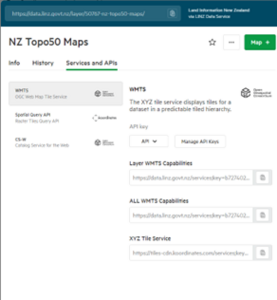The LDS web map tile services simplify access to data for analysis and visualisations. They let you directly incorporate Toitū Te Whenua data into your web, mobile or GIS application through pre-rendered map tiles.
LDS map tile services are available as a Web Map Tile Service (WMTS) for use in GIS applications, and as an XYZ service for web and mobile mapping.
Map services overview
LDS web map tile services:
- deliver fast access to pre-rendered, cached map tiles
- provide authoritative and up-to-date tiled map data
- release data under a Creative Commons Attribution 4.0 International licence
- have an open API for easy web, mobile and GIS integration
- use existing LDS API key system.
Specifications
The LINZ Data Service tile service has been implemented to the following specifications:
- OGC-compliant WMTS version 1.0 implemented.
- Supports OGC WMTS tile requests and XYZ style tile requests.
- WGS 84 / Web Mercator projection for use in web development.
- NZTM2000 projection for use in localised projects or GIS applications.
- Supports RESTful requests (KVP and SOAP request interfaces are not supported).
- Supports PNG image format for tiles.
- PNG tile returns to support transparency for data overlays.
- Uses Content Distribution Network (CDN) for fast serving of map tile images.
Tile matrix sets
Most LDS map tile services are available in 2 projections: Web Mercator (EPSG:3857) and NZTM2000 (ESPG:2193). Each has its own tile matrix set that describes the zoom levels, scale and resolution for the pre-rendered, cached images that are returned.
Refer to the LDS tile services tile set schema documents below for more information on the specifications of these tile sets.
WGS84 Web Mercator (EPSG:3857)
This tile set is most suitable for web mapping applications, and is compatible with Google Maps, OpenStreetMap and Bing Maps tiles without re-projection or scaling.
NZTM2000 (EPSG:2193)
This tile set is most useful for New Zealand geospatial professionals and can be used for desktop GIS mapping. It is also recommended for New Zealand mainland web applications when area and distances need to be well represented on the map.
Responses
Tile image requests are returned from the tile cache as compressed PNGs. See the Tile services tile set definition document for information on image resolution (pixel size).
The PNG format was chosen as it allows image quality to be maintained with relatively small file sizes. It also supports background transparency which is important for overlaying datasets or combining multiple layers together.
PNG is the only format supplied. The LDS WMTS service does not support on-the-fly conversion of image formats.
When tiles outside the map coverage area are requested, any tile returned will be transparent.
On demand cache
A tile is cached on the server only after that tile has been requested by a user.
Tiles are cached on a rolling basis. There may be some fluctuation in tile responses as tiles are cached during an initial request, drop off the cache store, and are re-cached.
Data that comprise LDS map tile services are frequently updated. You may experience a temporary dip in performance as the cache is flushed and tiles are re-cached by users following a data update.
Rate limiting
To guarantee reasonable performance levels and guard against overuse or abuse of our free tile services, these services are rate limited. It is highly unlikely that rate limiting will impact the use of tile services in GIS applications.
Accessing LDS web map tile services
Tile services are available for our aerial photos, topographic maps, hydrographic chart images and property boundary datasets published on the LINZ Data Service.
To access these services you need to create a LDS API key. You can create multiple keys to use across this and other LDS APIs, such as our Web Feature Service.
You can use your LDS API key within any LDS web service or API URL endpoint request. If you are logged in to LDS and select a web service URL, your web service key is automatically populated in the URL.
Client-side authentication is not required, as LDS recognises you as a registered user of LDS tile services through the API key.
Selecting a map tile service
Select the Services and APIs tab of any raster dataset to view the available tile services and the request URLs, then copy and paste the relevant URL into your application.

If you are logged in to LDS and have already created an API key, your API key and the layer ID will be pre-populated in the URL.